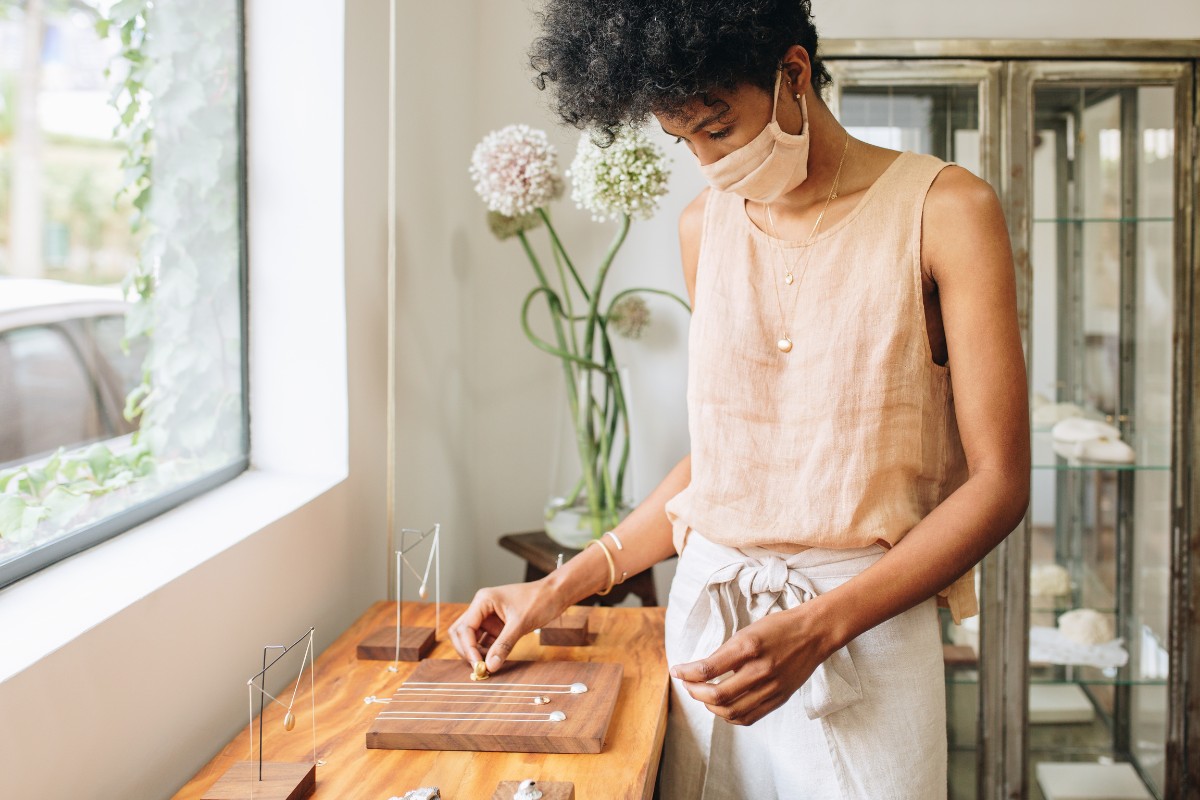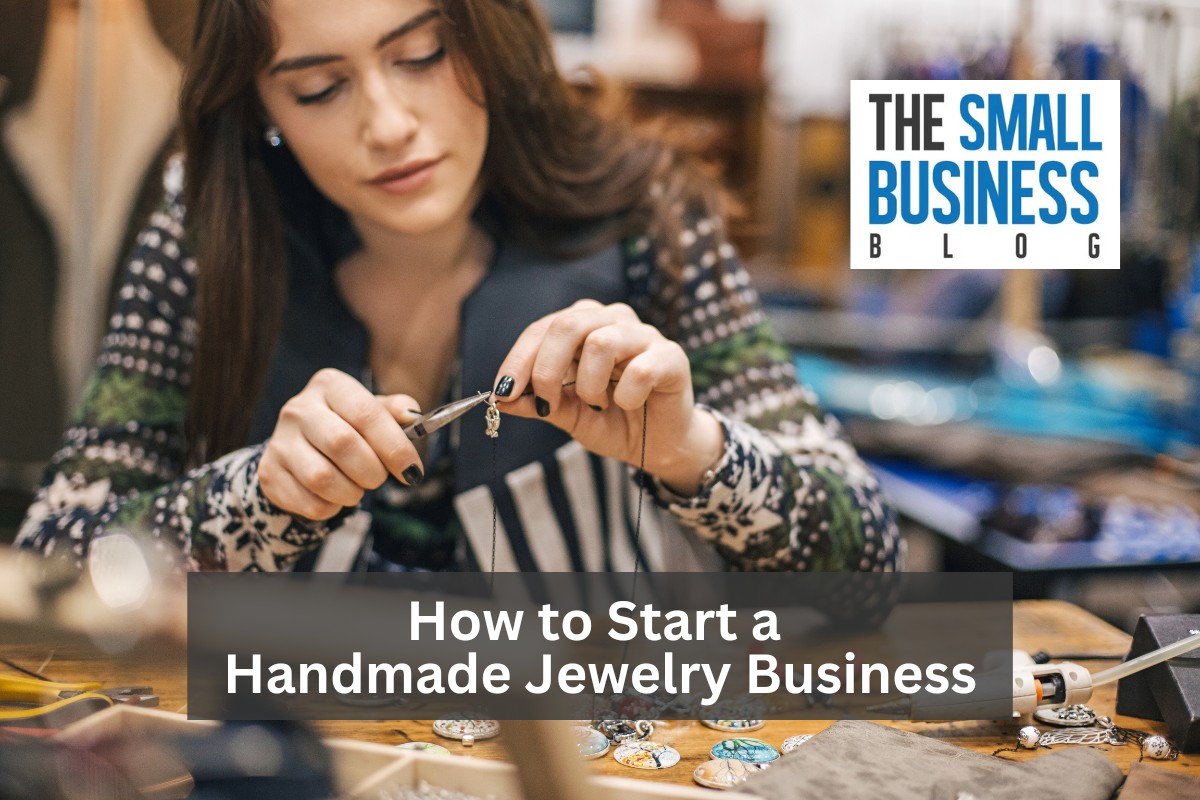In a world dominated by mass-produced items, handmade jewelry stands out as a beacon of creativity and individuality.
For those with a passion for crafting and an eye for design, starting a handmade jewelry business can be fulfilling and profitable.
This guide will take you through the essential steps to turn your dream into reality and help you learn how to start a handmade jewelry business.
Post Contents
- 1 How to Start a Handmade Jewelry Business
- 2 Frequently Asked Questions
- 3 Conclusion
How to Start a Handmade Jewelry Business
Here is a step-by-step guide to help you out.
1. The Vision and Planning Phase

Identifying Your Niche
Before you dive into the world of handmade jewelry, it’s essential to identify your niche.
The handmade jewelry industry offers a diverse range of possibilities, including:
- Beaded Jewelry: Using beads, gemstones, and crystals to create unique pieces.
- Metalwork: Crafting jewelry from metals like silver, gold, or copper.
- Wire Wrapping: Utilizing wire to create intricate designs.
- Resin Jewelry: Incorporating resin to encapsulate elements like flowers and charms.
- Upcycled or Vintage: Repurposing old jewelry pieces into new creations.
When selecting your niche, consider your interests, the market demand, and unique selling points.
Creating a Business Plan
A well-structured business plan is your roadmap to success.
It should include:
- Business Goals: Define what you want to achieve with your jewelry business.
- Target Audience: Understand your ideal customers and their preferences.
- Competitive Analysis: Research other handmade jewelry businesses in your niche.
- Marketing Strategy: Plan how you’ll promote your products.
- Financial Projections: Estimate your startup costs and revenue expectations.
2. Legal and Financial Foundations
Business Structure and Registration
Choosing the proper legal structure for your business, whether a sole proprietorship, LLC, or corporation, is crucial.
Register your business according to your local laws and obtain any necessary permits or licenses.
Budgeting and Financing
To kickstart your business, calculate your startup costs, which may include:
- Materials and Tools: Invest in high-quality supplies and essential tools.
- Workspace: Set up a functional and safe workspace for crafting.
- Website and Marketing: Create an online presence to reach a broader audience.
- Initial Inventory: Build a small inventory of your handmade jewelry.
Secure funding through personal savings, loans, or crowdfunding if needed.
3. Designing and Crafting Your Jewelry
Sourcing Materials and Tools
Finding suitable materials and tools is crucial for creating high-quality jewelry.
Consider:
- Local Suppliers: Check for local bead shops, craft stores, or metal suppliers.
- Online Suppliers: Explore online platforms for a broader selection and competitive prices.
- Quality vs. Cost: Balance the quality of materials with your budget.
Designing Your Jewelry
Unleash your creativity by seeking inspiration from nature, fashion trends, or personal experiences.
Sketch your designs and plan the materials you’ll use.
Crafting Techniques
Learning and mastering jewelry-making techniques is an ongoing process.
Practice and experimentation are crucial to improving your craft.
Resources like online tutorials and books can help you develop your skills.
4. Setting Up Your Workspace

Creating a Functional Workstation
A well-organized workspace is essential for efficiency and safety.
Ensure you have:
- Adequate Lighting: Good lighting is crucial for detailed work.
- Proper Ventilation: Protect yourself from fumes if you use chemicals.
- Safety Equipment: Use gloves, goggles, and aprons when needed.
- Ergonomic Setup: Prevent strain and discomfort during long crafting sessions.
Storage and Inventory Management
Keep your materials and inventory organized to avoid clutter and waste.
Use storage solutions like bins, drawers, and shelves to maintain order.
5. Branding and Marketing Your Jewelry
Branding Your Handmade Jewelry
Building a brand identity sets you apart from the competition. Consider factors like:
- Logo and Brand Name: Create a memorable brand name and logo.
- Storytelling: Share your journey and passion through your brand story.
- Consistent Style: Maintain a consistent style in your jewelry and packaging.
Building an Online Presence
In today’s digital age, a professional website and active social media presence are vital.
Set up a user-friendly website to showcase your jewelry and engage with potential customers through platforms like Instagram and Facebook.
Pricing Your Jewelry
Determining the right pricing strategy is crucial.
Calculate your pricing by considering the following:
- Material Costs: Calculate the cost of materials in each piece.
- Labor and Overhead: Include your time and other expenses.
- Profit Margin: Determine a reasonable profit margin based on your market research.
Stay flexible and be willing to adjust your prices based on customer feedback and market demand.
6. Selling Your Handmade Jewelry
Choosing Sales Channels
Selecting the proper sales channels is essential for your success.
Options include:
- Online Marketplaces: Utilize platforms like Etsy, Amazon Handmade, or eBay.
- Local Markets and Craft Shows: Participate in local fairs and markets.
- Wholesale: Consider selling your jewelry to boutiques and retailers.
Evaluate the pros and cons of each channel based on your business goals.
Sales Techniques and Customer Service
Effective sales strategies involve excellent customer service.
Engage with customers, answer questions, and offer personalized recommendations.
Provide a seamless purchasing experience both online and offline.
7. Handling Legalities and Taxes

Legal Compliance
To avoid legal issues, be aware of copyright and trademark laws.
Protect your original designs through patents or trademarks if necessary.
Consult a legal expert to ensure you comply with local regulations and intellectual property rights.
Managing Taxes
Small business owners have tax obligations.
Keep thorough financial records, consult a tax professional, and understand tax deductions and credits that apply to your business.
8. Scaling Your Business
Expanding Your Product Line
As your business grows, consider expanding your product range.
Add new designs and products to keep your collection fresh and appealing to a broader audience.
Hiring Help
When your business reaches a certain point, you may need to hire employees or outsource tasks like website maintenance, marketing, or customer service.
Learn to manage a growing team efficiently.
Frequently Asked Questions
How much money do I need to start a handmade jewelry business?
Starting a handmade jewelry business can cost as little as $500 to $2,000, depending on the scale and materials you choose.
Your budget should cover supplies, tools, and initial marketing efforts.
Do I need formal training to make handmade jewelry?
While formal training isn’t mandatory, it can be beneficial.
Many successful jewelry makers are self-taught, learning from online resources and practice.
Consider taking classes or workshops to improve your skills.
How can I stand out in a competitive market?
To stand out, focus on unique designs and high-quality craftsmanship.
Build a strong brand, engage with your audience on social media, and provide excellent customer service to build a loyal customer base.
What legal considerations should I be aware of?
You may need to register your business, obtain permits or licenses, and protect your designs through copyrights or trademarks.
Consult with a legal expert to ensure compliance with local regulations.
How do I price my handmade jewelry?
Pricing should cover your costs and provide a reasonable profit.
Consider material costs, labor, overhead, and desired profit margin.
Research competitors’ prices and be flexible to adjust based on market feedback.
Conclusion
Learning how to start a handmade jewelry business is an exciting endeavor, but it requires careful planning, creativity, and a solid commitment to craftsmanship.
By following these steps and staying informed, you can turn your passion for creating beautiful jewelry into a thriving business.






























